We overestimate ourselves a little bit if we think hobbyist furniture is going to be heavily remembered as a style of the 2010s or 2020s or whatever - it might be known that this is the era that people started building a lot of hobby pieces and they didn't really match much on the commercial market.
You are using an out of date browser. It may not display this or other websites correctly.
You should upgrade or use an alternative browser.
You should upgrade or use an alternative browser.
So this Dovetailing business?...
- Thread starter Kaizen123
- Start date

Help Support UKworkshop.co.uk:
This site may earn a commission from merchant affiliate
links, including eBay, Amazon, and others.
Devmeister
Established Member
No. I jumped on the jig without reading the Manuel. When I did read it, I followed their marking convention.Have you done the pins round one way and the opposing pins round the other way trick yet ?
On a cherry toolbox I made for myself, the plan was to build the box and then saw the lid assembly free using the table saw. The problem is that one of the tails had to be wider by one saw blade kerf so all the tails would be equal when the lis closed.
This is how I was introduced to the concept of symmetrical dovetails on the D4. You need to set up a mirror image of the set up on the right side of the jig otherwise your wider upper tail locates toward the bottom on the opposing corner.
While not a difficult concept, I didn’t particularly like the idea.
The jig also makes the hounds tooth harder than by hand.
Lastly the jig fingers are set up to do 7 degree thrust tails. Fair enough. But that means using a 14 degree router bit with a 3/4 in depth of cut.
when you do half blinds, you need to change the angle of cutter used depending on the thickness of your sides. So the back thrus will be 7 degree and the front half laps will be whatever angle the maunuel tells you for thickness. The 7 (14 degree) degree cutter will cut 7 degree if your sides are 3/4 in thick. Most drawers don’t use 3/4 in thick sides.
I didn’t know this. So I cut some kitchen drawers front and back with the thru cutter. These were half in drawers with a one piece overlay front.
OPPS! So I marked out the half lap fronts and did them by hand with the tails done on the D4.
I talk about control. Hand tools give you control. As cool as the D4 is, you have to learn the restrictive rules of what you can do and what you can’t do.
Devmeister
Established Member
We overestimate ourselves a little bit if we think hobbyist furniture is going to be heavily remembered as a style of the 2010s or 2020s or whatever - it might be known that this is the era that people started building a lot of hobby pieces and they didn't really match much on the commercial market.
The commercial market is horrible. particle board and MDF. Veneers so thin you learn the term Burn Thru quickly. A burn thru is a sander mistake in finish. Drawer fronts are often sub fronts that fail frequently. Doors are barely glued together because of the use of stub tennons to fill the panel gaps. If you pop a door on a corner diagonally, the whole door comes apart. That is how we were able to salvage interior panels when we had to recut a frame. Melamine is the material of choice. A horrid nasty material! Do I need to go on?
while hobbyists may not have the skills of chippendale or townsend, they as a group have made some nice work that will survive and outlast the commercial stuff. The commercial guys may have fancier designs but the foundation for heirloom status isn’t there.
It'll definitely outlast the commercial stuff - much commercially made bits are probably expected to have a lifespan of 10-20 years.
Long ago, someone told me (I was working in a cabinet factory) - that kitchens should be replaced every 25 years (this was odd as my parents had a nice house - nicer than I'll ever see, and the house had built in cabinets from 1924 - they are still there. They did get the floor tiled and stripped the paint off of the built ins and stain them when we moved in (in 1980) and the countertops have been "re-did" as sooner or later, you beat them up. The non-critical countertops (opposite side of the wet and hot areas) are still original solids.
At any rate, Maybe 15 years ago, I heard a figure of "replacing the kitchen every 20 years", and last year I heard someone say "10-15".
People change furniture and kitchens due to color - often. I get that the narrative is from people who redo kitchens, but my grandfather would turn in his grave if he knew people were rolling kitchens into loans every couple of decades instead of saving, and the fact that people retire with mortgages would be something he couldn't really grasp.
Back to the furniture - since I started woodworking in 2005 (and it was a slow start), I've read often how the finest furniture being made now (more drastic than your statement) is made by amateurs. I think amateurs are in the middle, maybe along with the best of the factory furniture (that costs what custom furniture would, anyway...but back to the thing about colors - factory furniture will always do well on the finish and color because that's what people understand. At the mid level cabinet factory where I worked, face frames at the time and door bits were solid wood - the average poster here would struggle to match the quality of the finish work that was done there. Why? Because that's generally the only thing cabinets came back for - less than perfect color match - and that also means if someone has a cabinet or four that they got three years ago and they're replacing more, they will be comparing. Any shortcomings of workmanship could be filled in with putty or shellac stick -....wait for it..
...as long as the color of the repair didn't stand out.
At the top end where there are commissions from very wealthy people for high quality reproductions, the average person can't do the specialized trade work even if they're a 20 year woodworkers, so while basic stuff that's made by amateurs is nice, there may be curator comments in the future about the dominance of square work without too many curves or curved mouldings.
Long ago, someone told me (I was working in a cabinet factory) - that kitchens should be replaced every 25 years (this was odd as my parents had a nice house - nicer than I'll ever see, and the house had built in cabinets from 1924 - they are still there. They did get the floor tiled and stripped the paint off of the built ins and stain them when we moved in (in 1980) and the countertops have been "re-did" as sooner or later, you beat them up. The non-critical countertops (opposite side of the wet and hot areas) are still original solids.
At any rate, Maybe 15 years ago, I heard a figure of "replacing the kitchen every 20 years", and last year I heard someone say "10-15".
People change furniture and kitchens due to color - often. I get that the narrative is from people who redo kitchens, but my grandfather would turn in his grave if he knew people were rolling kitchens into loans every couple of decades instead of saving, and the fact that people retire with mortgages would be something he couldn't really grasp.
Back to the furniture - since I started woodworking in 2005 (and it was a slow start), I've read often how the finest furniture being made now (more drastic than your statement) is made by amateurs. I think amateurs are in the middle, maybe along with the best of the factory furniture (that costs what custom furniture would, anyway...but back to the thing about colors - factory furniture will always do well on the finish and color because that's what people understand. At the mid level cabinet factory where I worked, face frames at the time and door bits were solid wood - the average poster here would struggle to match the quality of the finish work that was done there. Why? Because that's generally the only thing cabinets came back for - less than perfect color match - and that also means if someone has a cabinet or four that they got three years ago and they're replacing more, they will be comparing. Any shortcomings of workmanship could be filled in with putty or shellac stick -....wait for it..
...as long as the color of the repair didn't stand out.
At the top end where there are commissions from very wealthy people for high quality reproductions, the average person can't do the specialized trade work even if they're a 20 year woodworkers, so while basic stuff that's made by amateurs is nice, there may be curator comments in the future about the dominance of square work without too many curves or curved mouldings.
Devmeister
Established Member
WARNING!
When a true woodworker enters the commercial field, one of three things will happen.
1). He becomes so dismayed and beat down that it becomes a matter of looking forward to a meager paycheck.
2). He becomes so dismayed that he leaves woodworking forever for other opportunities.
3). He gives the commercial world the middle finger and strikes out on his own doing commission work. That is how C Becksvort went. He was planning his exit the second day in the millwork industry.
How do you become a millionaire at woodworking? Simple! Start out as a billionaire!
When a true woodworker enters the commercial field, one of three things will happen.
1). He becomes so dismayed and beat down that it becomes a matter of looking forward to a meager paycheck.
2). He becomes so dismayed that he leaves woodworking forever for other opportunities.
3). He gives the commercial world the middle finger and strikes out on his own doing commission work. That is how C Becksvort went. He was planning his exit the second day in the millwork industry.
How do you become a millionaire at woodworking? Simple! Start out as a billionaire!
Devmeister
Established Member
I agree with your grand dad!!!!!It'll definitely outlast the commercial stuff - much commercially made bits are probably expected to have a lifespan of 10-20 years.
Long ago, someone told me (I was working in a cabinet factory) - that kitchens should be replaced every 25 years (this was odd as my parents had a nice house - nicer than I'll ever see, and the house had built in cabinets from 1924 - they are still there. They did get the floor tiled and stripped the paint off of the built ins and stain them when we moved in (in 1980) and the countertops have been "re-did" as sooner or later, you beat them up. The non-critical countertops (opposite side of the wet and hot areas) are still original solids.
At any rate, Maybe 15 years ago, I heard a figure of "replacing the kitchen every 20 years", and last year I heard someone say "10-15".
People change furniture and kitchens due to color - often. I get that the narrative is from people who redo kitchens, but my grandfather would turn in his grave if he knew people were rolling kitchens into loans every couple of decades instead of saving, and the fact that people retire with mortgages would be something he couldn't really grasp.
Back to the furniture - since I started woodworking in 2005 (and it was a slow start), I've read often how the finest furniture being made now (more drastic than your statement) is made by amateurs. I think amateurs are in the middle, maybe along with the best of the factory furniture (that costs what custom furniture would, anyway...but back to the thing about colors - factory furniture will always do well on the finish and color because that's what people understand. At the mid level cabinet factory where I worked, face frames at the time and door bits were solid wood - the average poster here would struggle to match the quality of the finish work that was done there. Why? Because that's generally the only thing cabinets came back for - less than perfect color match - and that also means if someone has a cabinet or four that they got three years ago and they're replacing more, they will be comparing. Any shortcomings of workmanship could be filled in with putty or shellac stick -....wait for it..
...as long as the color of the repair didn't stand out.
At the top end where there are commissions from very wealthy people for high quality reproductions, the average person can't do the specialized trade work even if they're a 20 year woodworkers, so while basic stuff that's made by amateurs is nice, there may be curator comments in the future about the dominance of square work without too many curves or curved mouldings.
In the states, kitchen gut outs are averaging six to ten years.
Finish is an issue. We had quite a finish department and toning was a skill. The big boys use conversion varnish. Don’t even consider stripping. Most of my work saw lacquer. My ex girlfriend bought a bed from Vietnam thru Mayfair. The whole bed was made from some form of plastic wood dust putty injected into molds. Heavier than a dead hippie and just horrid. One issue in the mainstream is that folks today have not learned what quality is. I had to explain to the ex girlfriend what a dovetail was. These people will drop 80,000 on a sports car but buy the cheapest furniture from Mayfair made in Vietnam. Go Figure!

£15.99 (£1.60 / count)
£27.44 (£2.74 / count)
3M 8822 Disposable-fine dust mask FFP2 (10-pack)
Amazon.co.uk

£16.99
£19.99
Respirator Mask,Safety Dust Face Cover,Dust Face Cover Paint Face Cover,Gas Mask With Filter,For Paint,Dust And Formaldehyde,Sanding,Polishing,Spraying And Other Work
ShenZHEN CIRY MINGYANG LITIAN ELECTRONIC ECOMMERCE

£10.10
£15.48
Portwest Browguard with Clear Visor, Size: One Size, Colour: Clear, PW91CLR
Amazon.co.uk

£9.99 (£1.00 / count)
£14.45 (£1.44 / count)
JSP M632 FFP3moulded Disposable Dustmask (Box of 10) One Size suitable for Construction, DIY, Industrial, Sanding, dust protection 99 Percent particle filtration Conforms and Complies to EN 149
Amazon.co.uk

£10.19 (£0.39 / count)
£11.99 (£0.46 / count)
Nicpro Carpenter Pencil with Sharpener, Mechanical Carpenter Pencils Set with 26 Refills, Case, Deep Hole Marker Construction Pencils Heavy Duty Woodworking Pencils for Architect (Black, Red)
NicproShop EU

£24.99
Facemoon Reusable Masks,Safety Masks,Dual Filter Masks, Paint, Dust, Epoxy Resin, Construction, Welding, Sanding, Woodworking, Chemical Reusable Gas Masks
ShenZHEN CIRY MINGYANG LITIAN ELECTRONIC ECOMMERCE

£199.00
£360.17
Trend Portable Benchtop Router Table with Robust Construction for Workshop & Site Use, 240V, CRT/MK3
Amazon.co.uk

£34.99 (£3.50 / count)
£39.99 (£4.00 / count)
VonHaus Chisel Set - 10pcs Woodworking Tools Set - Wood Carving Tools, Wood Chisel Sets with Sharpening Stone, Honing Guide and Storage Case
VonHaus UK
Jacob
What goes around comes around.
Forgot to add - Becksvoort sizing the pinholes to match a chisel is a good one too, though it might clash with freehand sawing - I quite like the fast but casual look.
Devmeister
Established Member
It'll definitely outlast the commercial stuff - much commercially made bits are probably expected to have a lifespan of 10-20 years.
Long ago, someone told me (I was working in a cabinet factory) - that kitchens should be replaced every 25 years (this was odd as my parents had a nice house - nicer than I'll ever see, and the house had built in cabinets from 1924 - they are still there. They did get the floor tiled and stripped the paint off of the built ins and stain them when we moved in (in 1980) and the countertops have been "re-did" as sooner or later, you beat them up. The non-critical countertops (opposite side of the wet and hot areas) are still original solids.
At any rate, Maybe 15 years ago, I heard a figure of "replacing the kitchen every 20 years", and last year I heard someone say "10-15".
People change furniture and kitchens due to color - often. I get that the narrative is from people who redo kitchens, but my grandfather would turn in his grave if he knew people were rolling kitchens into loans every couple of decades instead of saving, and the fact that people retire with mortgages would be something he couldn't really grasp.
Back to the furniture - since I started woodworking in 2005 (and it was a slow start), I've read often how the finest furniture being made now (more drastic than your statement) is made by amateurs. I think amateurs are in the middle, maybe along with the best of the factory furniture (that costs what custom furniture would, anyway...but back to the thing about colors - factory furniture will always do well on the finish and color because that's what people understand. At the mid level cabinet factory where I worked, face frames at the time and door bits were solid wood - the average poster here would struggle to match the quality of the finish work that was done there. Why? Because that's generally the only thing cabinets came back for - less than perfect color match - and that also means if someone has a cabinet or four that they got three years ago and they're replacing more, they will be comparing. Any shortcomings of workmanship could be filled in with putty or shellac stick -....wait for it..
...as long as the color of the repair didn't stand out.
At the top end where there are commissions from very wealthy people for high quality reproductions, the average person can't do the specialized trade work even if they're a 20 year woodworkers, so while basic stuff that's made by amateurs is nice, there may be curator comments in the future about the dominance of square work without too many curves or curved mouldings.
on Curves
While most amateurs focus on square work, you also have to consider the utilitarian purpose of what they made. When I needed a file caninet, of course it’s got square lines. Ever see a round filing cabinet?
stickly was influenced by scandavian lines and shaker lines. His initial work was very square. It was not until he hired Ellis before we saw more curves.
if you look at the work by Krenov, you see a unique style but one that is stil square even if it has the occasional coopered door.
the work done by chippendale et alhad square chest of drawers albeit some curves in the base skirts.
Details change the looks. The **** beading, the base molding, the crown molding. The same box can morph into a variety of styles.
Been thereHave you done the pins round one way and the opposing pins round the other way trick yet ?
on Curves
While most amateurs focus on square work, you also have to consider the utilitarian purpose of what they made. When I needed a file caninet, of course it’s got square lines. Ever see a round filing cabinet?
stickly was influenced by scandavian lines and shaker lines. His initial work was very square. It was not until he hired Ellis before we saw more curves.
if you look at the work by Krenov, you see a unique style but one that is stil square even if it has the occasional coopered door.
the work done by chippendale et alhad square chest of drawers albeit some curves in the base skirts.
Details change the looks. The **** beading, the base molding, the crown molding. The same box can morph into a variety of styles.
There's probably two realities here. There are folks into that (much of suburbia, maybe, but not usually older people who realize they're not going to blow the money to not be "embarrassed" by their kitchen - and then rural and urban areas where there's not a whole lot wasted on kitchens.).
It's a little weird to me - the house doesn't serve you when it adds 5 years to your working lifetime. You serve it, instead.
Derek Cohen (Perth Oz)
Established Member
on Curves
While most amateurs focus on square work, you also have to consider the utilitarian purpose of what they made. When I needed a file caninet, of course it’s got square lines. Ever see a round filing cabinet?
stickly was influenced by scandavian lines and shaker lines. His initial work was very square. It was not until he hired Ellis before we saw more curves.
if you look at the work by Krenov, you see a unique style but one that is stil square even if it has the occasional coopered door.
the work done by chippendale et alhad square chest of drawers albeit some curves in the base skirts.
Details change the looks. The **** beading, the base molding, the crown molding. The same box can morph into a variety of styles.
I have included curves into a lot of my furniture. Sometimes it is quite subtle to soften what appears to be a straight line. I recall posting a piece on this forum for discussion, and bemoaning how much longer it took to make. Custard (Gary?), a local professional in the UK, and whose work I admire, commented that any curve creates three times the effort and time needed compared with square work.
We do not see much work in this vein, and I think that a big factor is that there are so many complications when one moves off-square. This is a chest of drawers I built for my wife. Working weekends only, it took 18 months. The case is a tapered curve on the sides and is bow-fronted. The drawers were made to fit the angles, and as a result, all the half-blind dovetails are made at compound angles (splay to the drawer side along with a splay to the curved drawer fronts). For reference, the drawer fronts are figured Jarrah, and the drawer sides quartersawn Tasmanian Oak, both Australian. The case is Makore (from West Africa).
This was published by FWW magazine ..
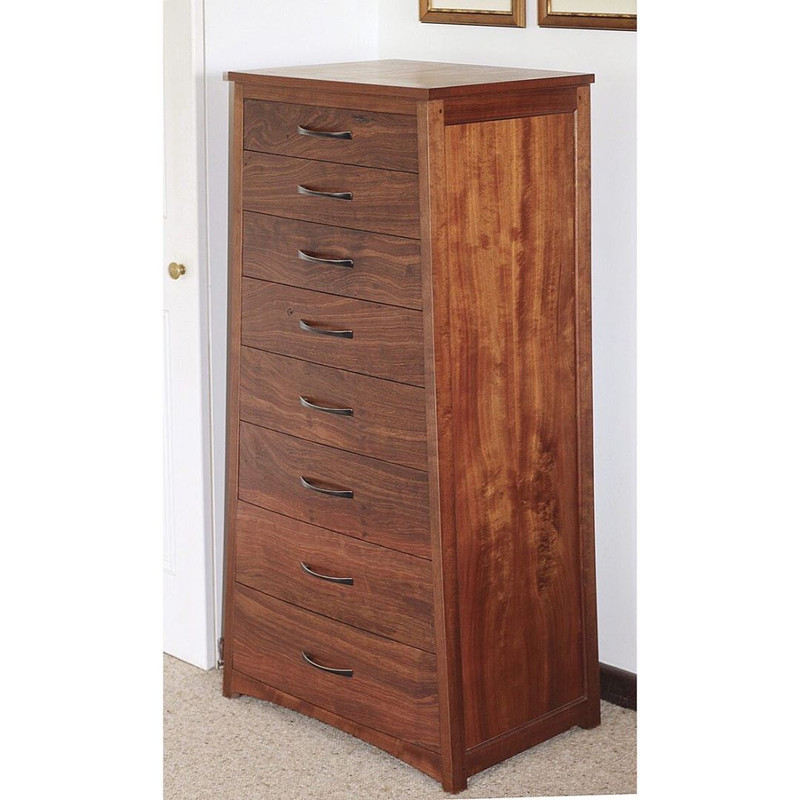

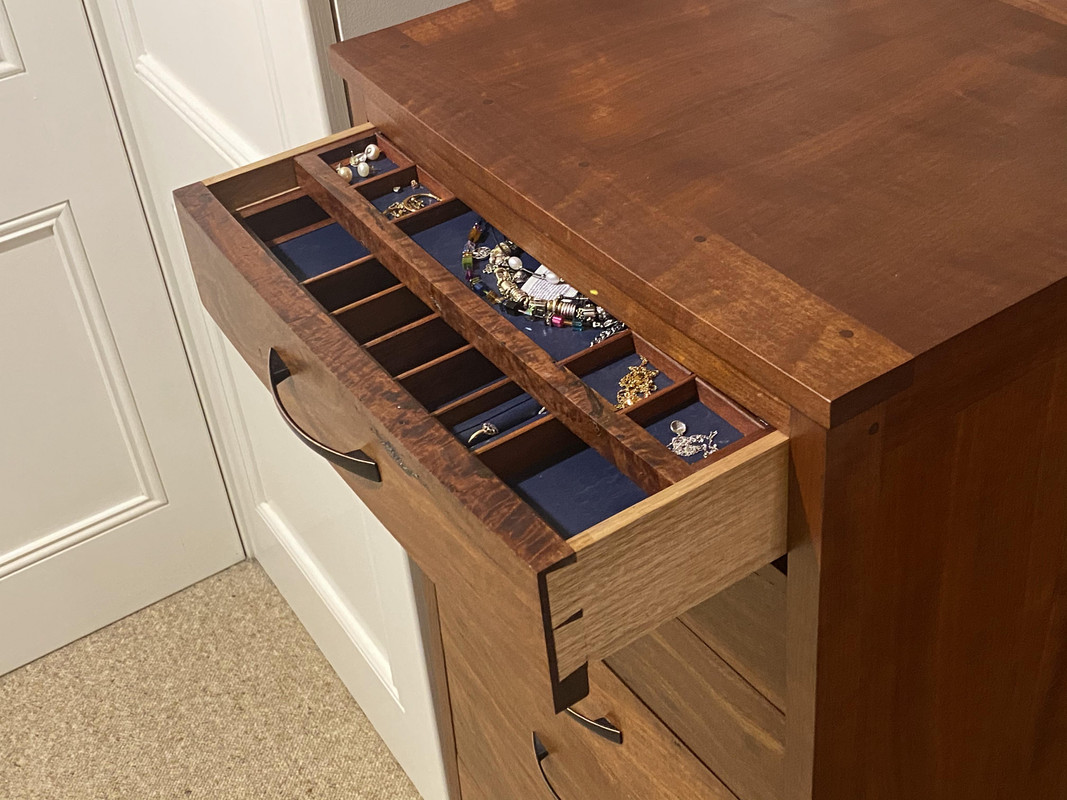
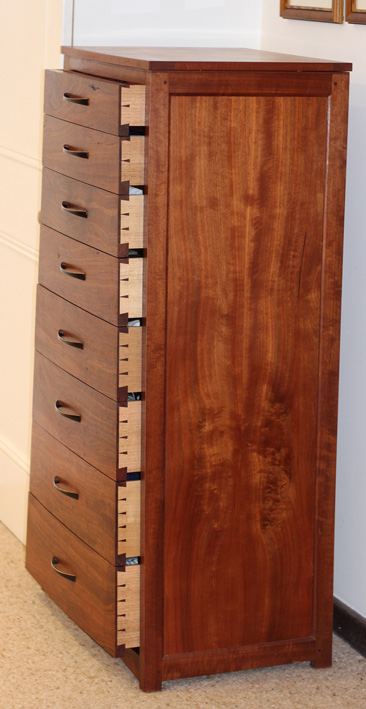
As David said, there are amateurs making furniture like this as few pros can do so economically. I do not reject the use of machine connectors, such as biscuit joiners or Dominos (I own both). However, my view is that they make the entry to furniture making so easy, that so many are unlikely to go past this stage and learn traditional joinery. And THAT condemns all the furniture made to landfill eventually (all joinery here was either mortice&tenon, sliding dovetails or dovetails).
The earlier comments about changing kitchens every 10 years, sometimes less, is all about the perception of value. I know David has made a kitchen for home, and I'm sure others here have as well. I built ours several years ago, updating and replacing one made commercially some 25 years earlier. It was not a decision made lightly. The old kitchen was quite serviceable and actually very nice looking (in Tasmanian Oak). But 25 years before we liked raised panels, and then 25 years later we did not. Still, the reason it was replaced was because I could do all of the work (as David did, and as others here have done). Costs come into it, but the perception of value-added was emphasised by the use of solid wood (in my case, USA Curly Maple). I love the outcome and it still brings a glow of pride. We will be selling the house in a few years when I retire, and no doubt someone will pull it out and replace it with veneer or paint.
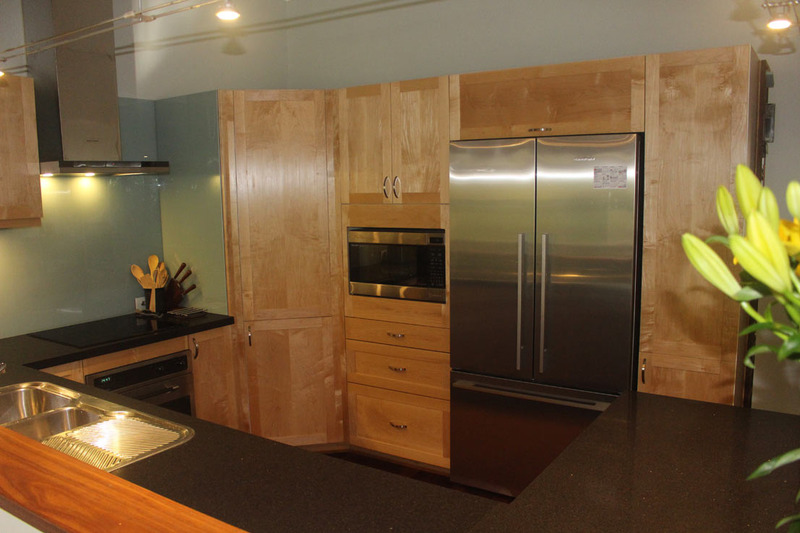
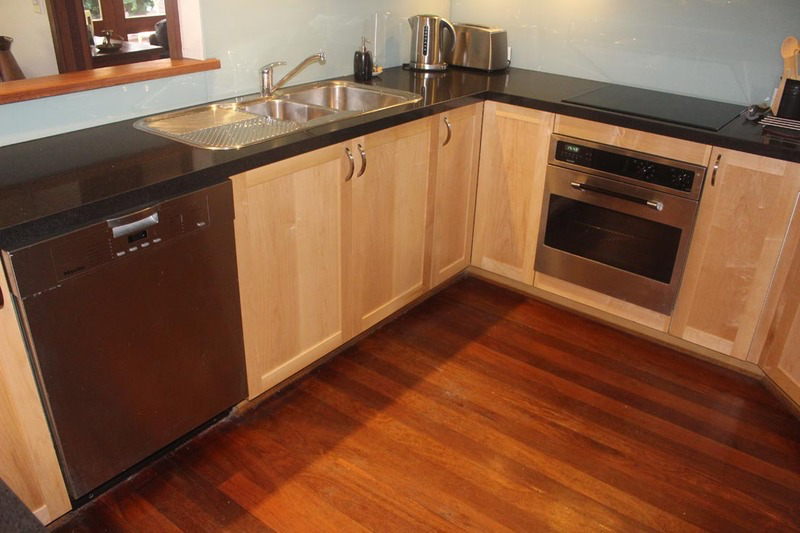
Bar stools made to match
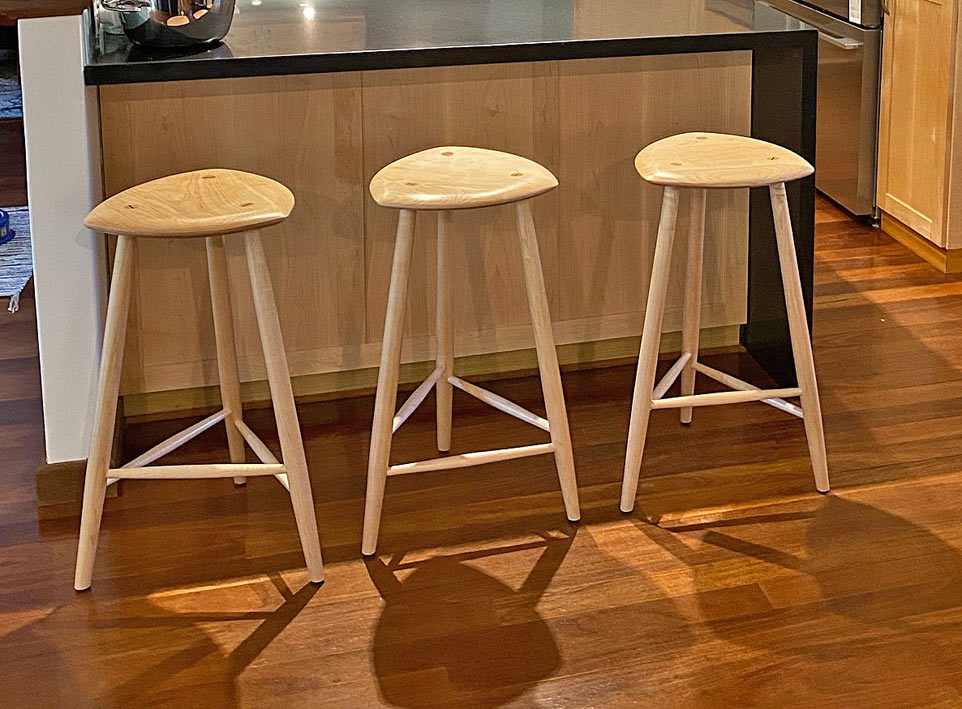
Amateurs rule!
Regards from Perth
Derek
Last edited:
@Derek Cohen (Perth Oz) as a learner I agree with you that all these power tools take away the ability to properly learn stuff. I was explaining what I've learned about dovetails so far to my better half and she said 'cant you just buy a tool that does it'. By the time I had said "yes but....' she had already Google'd a jig and gave me the price 
'why don't you just buy this?'
Harder to teach oneself properly but anyone can buy a jig. Depends what you're trying to achieve I suppose. For those that are looking for an interesting side hustle maybe a jig and a plethora of power tools is the way to go but if you actually appreciate craftsmanship then you can literally learn anything these days off your own steam with the internet square in your pocket and a bit of effort.
'why don't you just buy this?'
Harder to teach oneself properly but anyone can buy a jig. Depends what you're trying to achieve I suppose. For those that are looking for an interesting side hustle maybe a jig and a plethora of power tools is the way to go but if you actually appreciate craftsmanship then you can literally learn anything these days off your own steam with the internet square in your pocket and a bit of effort.
@Derek Cohen (Perth Oz) Thanks for the amazing resource that is your website. Definitely a standard for any hobbyist to aspire to!
When you retire and sell your house, do you still plan to have a workshop at your next one and do more woodworking or are you going to down tools as well?
When you retire and sell your house, do you still plan to have a workshop at your next one and do more woodworking or are you going to down tools as well?
Cooper
Established Member
I remember children doing that when they made jewellery boxes and finding they had made a staircase!!Tails only on two boards and pins only on two boards. Don't mix tails on one end and pins on the other end of a board, as you won't get the box together.
At the same time one lad made a really neat box from pine with dovetails. It was just after the Brixton Riots ( the school was just up the road from the action) and Charles and Dianna came to our hastily arranged Christmas Fair, to show solidarity with the community. As the Art and D&T departments had good examples of course work we put on an exhibition on in the Foyer with the children whose work was exhibited. Charles was brought along the line and looked at the box and said to the boy. "And how will you be finishing it? With inlay?". When he was out of ear shot, the boy said 'What's e goin on about sir." I said "Raymond he lives in a palace, everything he sees is over decorated. He can't see how elegant a simple object can be."
All these memories from a conversation about dovetails.
Derek Cohen (Perth Oz)
Established Member
@Derek Cohen (Perth Oz) Thanks for the amazing resource that is your website. Definitely a standard for any hobbyist to aspire to!
When you retire and sell your house, do you still plan to have a workshop at your next one and do more woodworking or are you going to down tools as well?
No fear, BD. And thanks for the kind words. The website hopefully offers ideas, methods and passion in equal amounts.
We plan to sell up in about 3 years (I turned 72 less than a week ago). I might have been tempted to retire sooner, but Covid has placed a demand on my work (I am a child psychologist), and there is a shortage of specialists. Woodworking is my therapy, so it is very far from being something I will set aside. We have another house, not far from where we live, which is smaller and will not have the garden and pool to upkeep. It does lack a workshop, and building one from scratch is something that will be interesting (I've never had that privilege). I read with interest the experiences of others.
Regards from Perth
Derek
Jacob
What goes around comes around.
Absolutely................ many are unlikely to go past this stage and learn traditional joinery. And THAT condemns all the furniture made to landfill eventually (all joinery here was either mortice&tenon, sliding dovetails or dovetails)...........
Derek's stuff is of course immaculate but not to lose sight of the fact that even ordinary trad furniture at the cheap end of the scale, with speedily hacked out irregular dovetails, cheap materials, has quality and will outlast most modern garbage.
Just a detail - one odd thing about the modern amateur is the reliance on expensive bought drawer runners. Trad solid wood runner design is easy to implement, costs nothing (just offcuts usually), works well and lasts for years.
Bring back the traditional drawer runner!
Derek Cohen (Perth Oz)
Established Member
@Derek Cohen (Perth Oz) as a learner I agree with you that all these power tools take away the ability to properly learn stuff. I was explaining what I've learned about dovetails so far to my better half and she said 'cant you just buy a tool that does it'. By the time I had said "yes but....' she had already Google'd a jig and gave me the price
'why don't you just buy this?'
Harder to teach oneself properly but anyone can buy a jig. Depends what you're trying to achieve I suppose. For those that are looking for an interesting side hustle maybe a jig and a plethora of power tools is the way to go but if you actually appreciate craftsmanship then you can literally learn anything these days off your own steam with the internet square in your pocket and a bit of effort.
Kaizen, if you really want to learn to dovetail, there are really just two skills to master:
1. Get your head around the marking out. It took me a while as I am spatially challenged! I would get everything backwards or upside down.
2. Be brave, develop a "go for it" attitude, and saw to the line (the correct side of the line!
My eyes are old and I struggled to see the lines, especially in dark woods. So I developed the blue tape method. Try it out - it makes it easy to ensure the lines are clear and where you need to saw.
Here are two pictorials from my website:
Through dovetails: http://www.inthewoodshop.com/Furniture/ThroughDovetails3.html
Half-blind dovetails: http://www.inthewoodshop.com/Furniture/HalfBlindDovetailswithBlueTape.html
Regards from Perth
Derek
Jacob
What goes around comes around.
You are using some hefty pieces of wood, as for a strong box. That DT might work better if the 'half' pin on the edge was twice as wide, they don't have to be literally half the width of the others. As it is it'd be vulnerable even if the thing had gone together OK to start with.Starting to notice a pattern here...
Why not have a go at a real box of some sort, with thinner sides? If it doesn't come out OK you just trim the ends and start again with a smaller box
Yes I did think they were a bit chunky and maybe it'd be a lot simpler and possibly even, dare I say it, easier with some thinner wood. I find lots of thinner tails look nicer but I guess one or two big ones might be stronger? Not sure. The biggest pain in the arse so far has definitely been chiselling the bottom of the sockets out. Anyway I'm leaving this little project there because I layed out the boards wrong anyway so can't do the 4 sides. Leaving it at 3 and I'm going to attempt to mill the thickness down on the table saw and round them off. It'll stay in the shed staring me in the face as a reminder of this 5hrs work only to not be able to complete the box because I didn't fully think it through!You are using some hefty pieces of wood, as for a strong box. That DT might work better if the 'half' pin on the edge was twice as wide, they don't have to be literally half the width of the others. As it is it'd be vulnerable even if the thing had gone together OK to start with.
Why not have a go at a real box of some sort, with thinner sides? If it doesn't come out OK you just trim the ends and start again with a smaller box
As I said at an earlier point in this thread I'm just going to keep on Dovetailing with anything I do if it needs joining for a while and hopefully it's going to sink in and a light bulb will turn on upstairs.
Similar threads
- Replies
- 42
- Views
- 3K
- Replies
- 13
- Views
- 1K

























